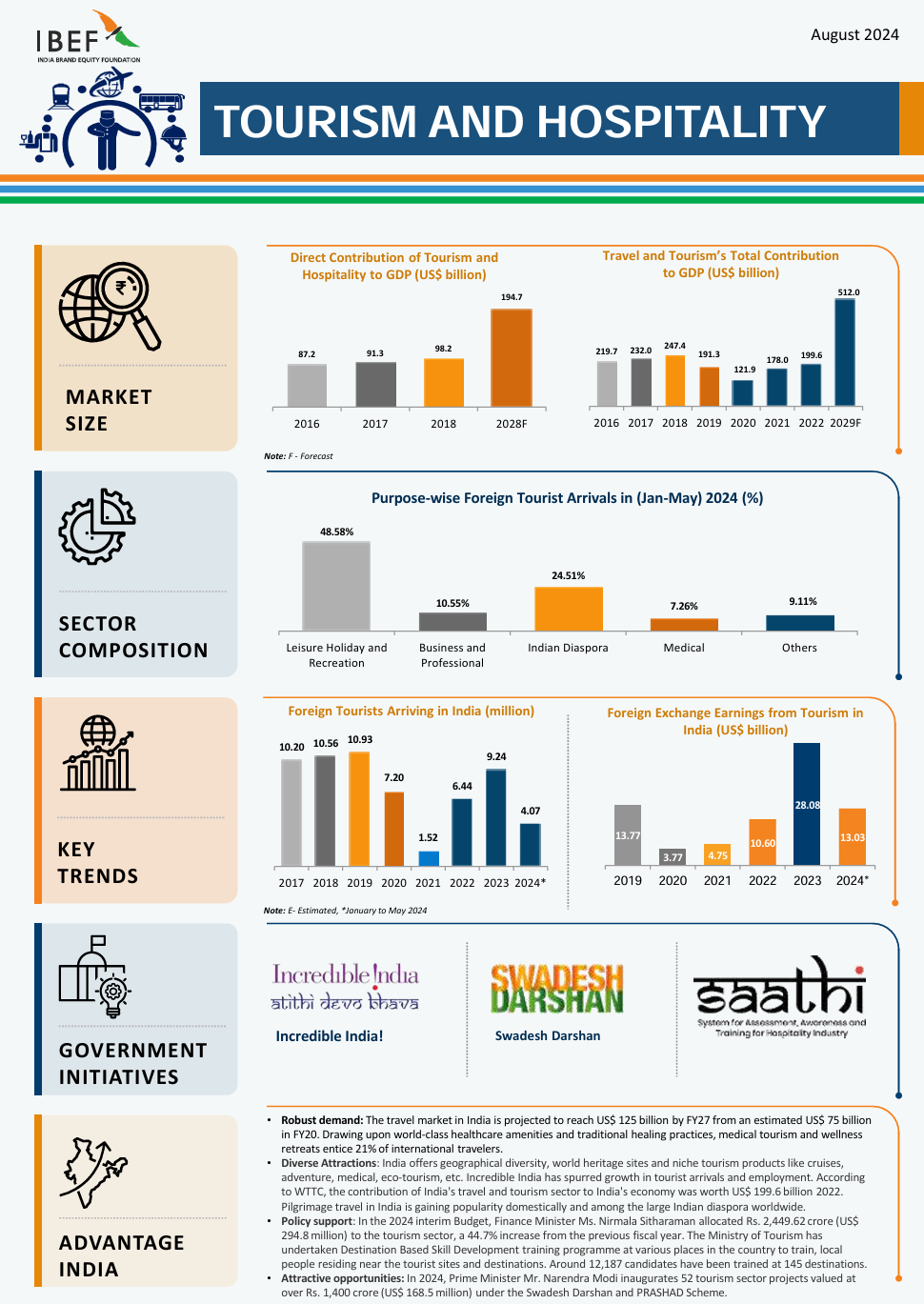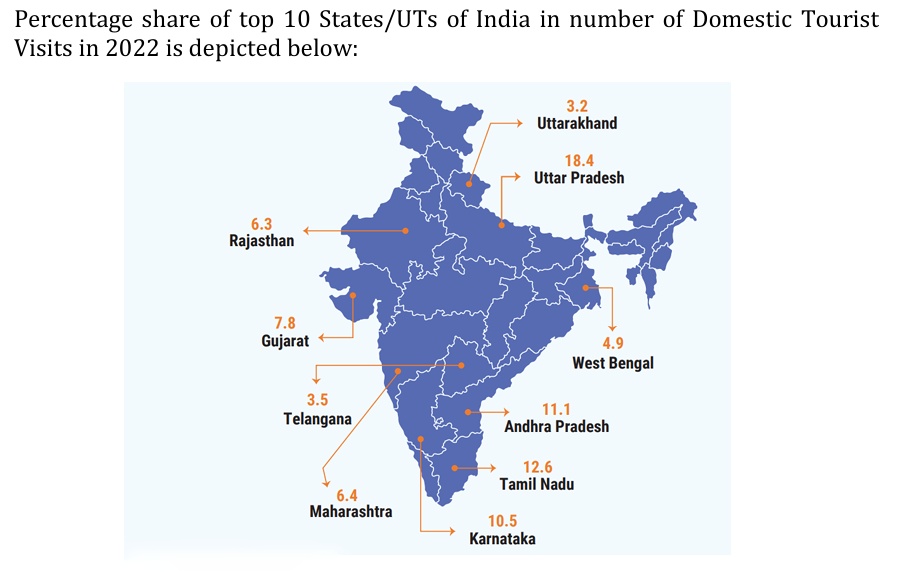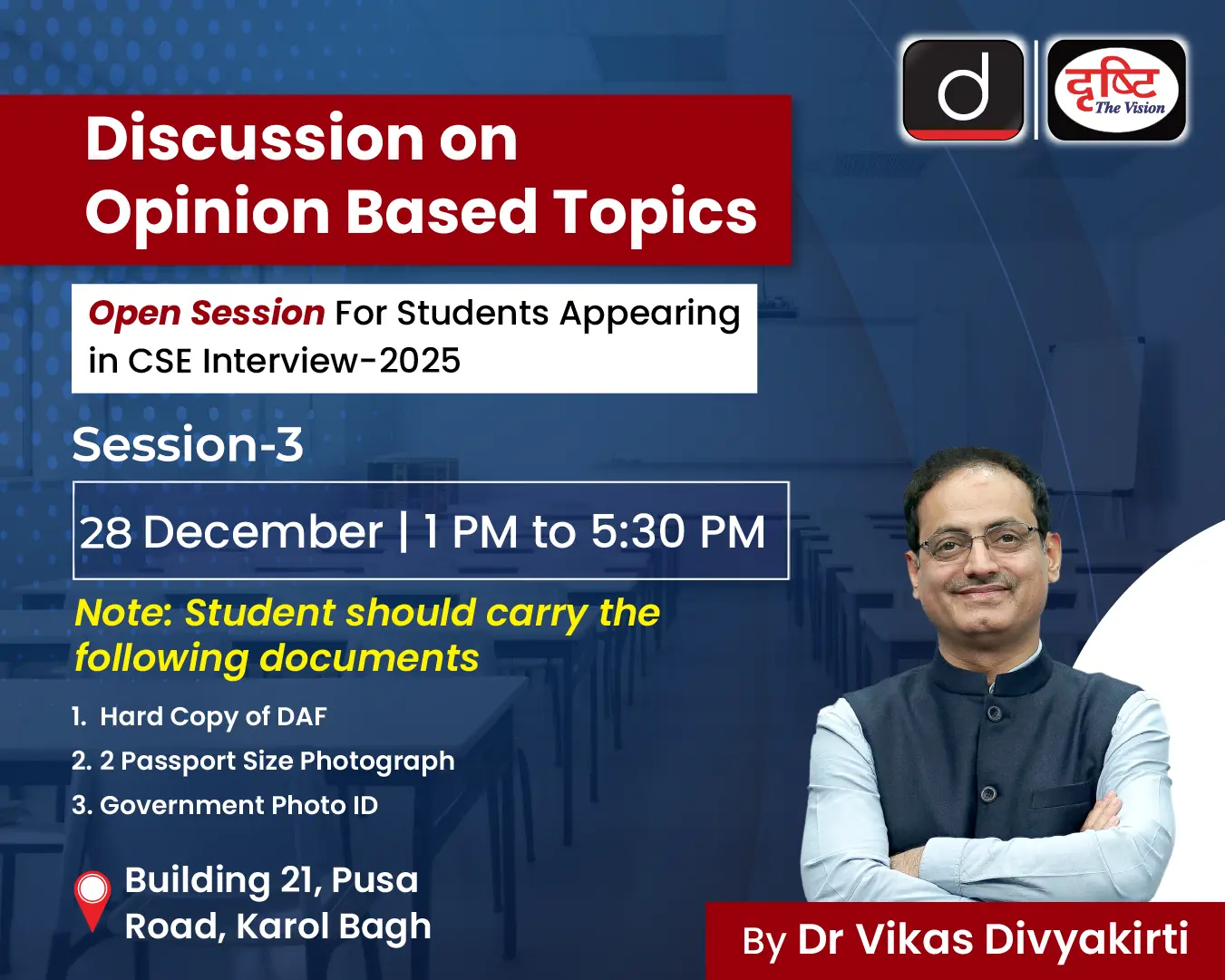Indian Economy
World Tourism Day 2024
- 28 Sep 2024
- 13 min read
For Prelims: World Tourism Day, United Nations World Tourism Organization, Sustainable Development Goals, Gross Domestic Product, Travel and Tourism Development Index , National Tourism Policy 2022, Dekho Apna Desh Initiative, Swadesh Darshan Scheme, Himalayas, Hampi,
For Mains: Significance of the Tourism Sector in India, Challenges Related to the Tourism Sector in India, Recent Initiatives Related to Tourism in India.
Why in News?
The Ministry of Tourism celebrated World Tourism Day on 27th September 2024, with the theme “Tourism and Peace.” focusing on how tourism contributes to promoting world peace by encouraging cross-cultural interactions and understanding.
What is the Significance of World Tourism Day?
- History: World Tourism Day was first celebrated in 1980 by the United Nations World Tourism Organization (UNWTO), and raises awareness about the social, cultural, and economic importance of tourism.
- The day marks the adoption of UNWTO’s statutes in 1975, signifying its official establishment five years later.
- UNWTO advocates for tourism as a driver of economic growth, inclusive development, and environmental sustainability while supporting the sector in advancing knowledge and policies worldwide.
- UNWTO comprises 160 Member States (including India), 6 Associate Members, 2 Observers, and over 500 Affiliate Members.
- Headquartered in Madrid, Spain.
- Annual Themes: Each year, World Tourism Day is celebrated with a specific theme and a host country, highlighting the unique role tourism plays in different regions around the world.
- In 2024, Georgia will have the honour of hosting this important event. The theme for World Tourism Day 2024 is particularly inspiring: "Tourism and Peace."
- The day emphasises tourism’s potential as a tool for achieving the UN Sustainable Development Goals (SDGs), particularly in poverty eradication and sustainable resource management. It also highlights the importance of eco-tourism in supporting SDG 13 on climate action.
How does Tourism Contribute to Peace?
- Cultural Exchange: Tourism promotes understanding and tolerance among diverse cultures, reducing prejudice through shared experiences and dialogue.
- Economic Empowerment: As a major driver of economic growth (tourism contributes 10% of global Gross Domestic Product (GDP), 7% of global exports and accounts for one in every 10 jobs worldwide), tourism creates jobs and strengthens local economies, which can alleviate poverty and inequality, which can be root causes of conflict.
- Sustainability: Responsible tourism practices conserve natural and cultural heritage, fostering community pride and reducing resource-related tensions.
- Good Governance: A thriving tourism sector encourages governments to maintain stability and develop policies that promote peace and functionality.
- Gender Equality: The tourism industry empowers women and engages local communities.
- The Tribal Home Stays (under Swadesh Darshan program), implemented by the Ministry of Tourism of India, aims to tap into the tourist potential of tribal areas and provide an alternative livelihood to the tribal community.
- This initiative fosters social equity and reduces inequalities.
- Pandemic Recovery: Tourism aids in rebuilding economies and promoting healing in post-conflict areas, as seen in countries like Rwanda.
- Rwanda's GDP grew by 8.4% in the first three quarters of 2022, following an 11% increase in 2021. This growth was driven by the services sector, particularly the revival of tourism, which improved employment indicators to levels similar to early 2020, before the Covid-19 pandemic.
What is the Outlook of India’s Travel and Tourism Industry?
- Global Ranking: India ranks 39th in the World Economic Forum's Travel and Tourism Development Index 2024. Its strong performance is driven by exceptional natural, cultural, and non-leisure resources(resources that are utilised for business, education, and other activities outside of leisure travel).
- Economic Contribution: According to the World Travel & Tourism Council (WTTC) , the contribution of India's travel and tourism sector to India's economy was worth USD 199.6 billion in 2022.
- Cumulative Foreign Direct Investment (FDI) inflow in the hotel and tourism industry stands at USD 17.2 billion from April 2000 to March 2024. This constitutes 2.54% of the total FDI inflow received across sectors.
- Rise of Domestic Tourist Visits (DTV) in 2023 reached 250 crore, nearly double from 128 crore in 2014.
- Government Initiatives:
- Growth Projections:
- Annual Growth Rate: The Indian travel and tourism industry is expected to grow at an annual rate of 7.1%.
- Job Creation: The Government of India has a vision of USD 56 Billion forex, , creating around 140 million jobs in tourism by 2030 through inclusive growth and are particularly focusing on cruise tourism, ecotourism and adventure tourism.
- Visitor Spending Trends: Domestic visitor spending surged by 20.4% in 2022, while international visitor spending increased by 81.9%.
- Foreign Tourist Arrivals (FTAs): FTAs reached 9.24 million in 2023, a notable rise from 6.43 million in 2022.
- The top countries for FTAs in India during 2022 are the United States, Bangladesh, and the United Kingdom. FTAs are expected to reach 30.5 million by 2028.
What are the Challenges Related to the Tourism Sector in India?
- Safety and Security Issues: Instances of crime, including theft and assault, have been reported, creating an atmosphere of fear, particularly for women travellers.
- Such security issues can deter tourists from visiting certain areas, affecting the overall perception of India as a tourist-friendly country.
- Inadequate Infrastructure: Many tourist destinations, especially in remote regions like the Northeast, lack essential infrastructure such as reliable air, rail, and road connectivity. This limits access to beautiful yet unexplored areas, affecting domestic and international travel.
- Unskilled Human Resources: The tourism sector suffers from a lack of trained manpower, including multilingual guides. This shortage can hinder the overall experience for international tourists and impact service quality.
- Unsustainable Tourism Practices: Unsustainable tourism practices, especially in ecologically sensitive areas like the Himalayas, lead to resource depletion, soil erosion, and habitat destruction. The overconsumption of resources strains local ecosystems and communities.
- Pollution and Climate Change: Major tourist sites, including the Taj Mahal, are affected by pollution. Climate change poses further threats, leading to natural disasters that impact tourism infrastructure and heritage conservation.
What are India's Tourism Advantages?
- Rich Cultural Heritage: India is a mosaic of languages, religions, and traditions. Home to UNESCO World Heritage sites like the Taj Mahal, Hampi, and Jaipur’s forts that attract tourists interested in history and culture.
- Natural Beauty: India boasts 70% of the Himalayas (Home to numerous adventure sports and trekking opportunities).
- 7,000 km of coastline (ideal for water sports and beach tourism). India has both hot and cold deserts.
- Extensive forest cover which can aid in boosting ecotourism.
- India’s biodiversity hosts unique flora and fauna, including national parks like Jim Corbett and Kaziranga.
- Adventure Tourism Potential: With a range of activities like trekking, river rafting, paragliding, and wildlife safaris available, India is poised to become a premier destination for adventure tourism.
- Affordable Travel Options: India offers relatively low travel costs compared to many Western countries, making it accessible for various income groups, thereby attracting a diverse range of tourists.
- Warm Hospitality: The Indian ethos of "Atithi Devo Bhava" (Guest is God) ensures warm and welcoming experiences for visitors.
- Locals are generally eager to help and share their rich cultural heritage with tourists, enhancing their overall experience.
- Culinary Diversity: The country boasts varied culinary experiences across its regions, known for both vegetarian and non-vegetarian dishes. Its popular street food offerings cater to food lovers seeking authentic local flavours.
- Growing Infrastructure: India is enhancing tourism infrastructure through airport expansions, railway improvements, and highway developments under initiatives like Bharatmala.
- Investments in hospitality and skill development programs aim to improve service quality and accommodate growing visitor numbers.
Way Forward
- Enhance Connectivity: Invest in transportation initiatives like Vande Bharat trains and infrastructure development to improve access to remote tourist destinations.
- Tax Simplification: Advocate for streamlined tax reforms, including lower Goods and Services Tax (GST) rates, to reduce costs for tourists and businesses.
- Prioritise Safety: Establish tourism police and implement strict security protocols to boost tourist confidence in safety.
- Skill Development: Invest in training programs for the tourism workforce to improve service quality and cultural sensitivity.
- Leverage Digital Technology: Enhance existing initiatives like the Digi Yatra app and leverage Bhashini to facilitate multilingual support, ensuring a seamless travel experience for all users.
- Additionally, utilise social media and travel websites to increase the visibility of destinations and streamline trip planning.
- Embrace Staycation Trends: Major hotel chains like Marriott, and Oberoi are embracing the staycation trend by offering curated experiences that provide stress relief and luxurious getaways. By promoting staycations, hotels can enhance occupancy rates and stimulate the local economy through increased spending on nearby attractions and services.
- International Partnerships: Explore travel bubbles with countries like Russia to facilitate tourism while implementing health safety protocols.
- The concept of sister cities can enhance these partnerships by fostering cultural exchange, economic collaboration, and mutual support in tourism initiatives.
|
Drishti Mains Question: Discuss the significance of World Tourism Day and evaluate the current outlook of India’s travel and tourism industry and propose strategies to address them. |
UPSC Civil Services Examination, Previous Year Question (PYQ)
Mains
Q.1 How can the mountain ecosystem be restored from the negative impact of development initiatives and tourism? (2019)
Q.2 The states of Jammu and Kashmir, Himachal Pradesh and Uttarakhand are reaching the limits of their ecological carrying capacity due to tourism. Critically evaluate. (2015)









